“For the dead and the living, we must bear witness.”
― Elie Wiesel
I think of a thousand ways to start this story.
But when I look back over each beginning, I feel like the writer equivalent of a girl before a first date, holding up an endless series of possible outfits to her bedroom mirror, all of them okay, none of them just right.
Because here’s the thing, plain and simple: on a drizzling Sunday afternoon in Phnom Penh, Cambodia, I find myself with a few unexpected hours to spare. Almost instantly, I realize this gives me time to visit the Choeung Ek Genocidal Center – or a site better known as the Killing Fields – before moving on to Vietnam the next day.
And almost as soon as I arrive at the Killing Fields, as soon as I begin to wander its oddly tranquil paths, past the Memorial Stupa housing 5,000 human skulls from those killed by the Khmer Rouge, I can see that I was meant to come here.
That my feet were meant to sink into deep pools of mud even as I sink myself into this place and its tragic past.
Once I get past the false starts and the over-written introductions, I understand that all I really I want to write about are the bracelets.
I see three mass graves during my time at Choeung Ek (although 86 out of 129 have been uncovered so far) – one home to 450 victims, another that held women and children, a third that was filled with the bodies of Khmer Rouge soldiers, those whom Pol Pot accused of having a “Cambodian body, but Vietnamese head.”
Today the graves are protected beneath open-air shelters, with bamboo fences surrounding them – and on each and every fence post there are bracelets; brightly colored friendship bracelets, the kind I grew up braiding at camp, and ones made from ribbons and others that read “Cambodia” on their sides.
Thousands and thousands of bracelets, one on top of another on top of another – and for whatever reason, they are what move me the most.
Then I get to a tree, the Killing Tree, and my audio guide tells me that there used to be blood crusted on the trunk from the bodies of infants that were swung by their legs and smashed against it. And again, bracelets have been hung here; they hang tenuously from little pieces of bark and indeed many lay fallen on the ground.
I slip a bracelet off my wrist, an orange one I found on a street in Laos. I’d read that they were an important part of Baci ceremonies, tied onto a person’s wrist for good luck, and so I had worn it since to remind me of my time there. Now I leave it on the Killing Tree, just above a bracelet the color of blood, to hang until the wind moves it from its place.
And, so it seems, have thousands of others, slipping off whatever they happened to have on their wrist at the time and leaving it behind – as an act of love, or belief, or perhaps of prayer. Because what else can you do at a place where a million people died – and at the hand of their own countrymen?
What else can you do but think and pray and believe for healing and leave something, anything, behind that says we were here, and that we remember?

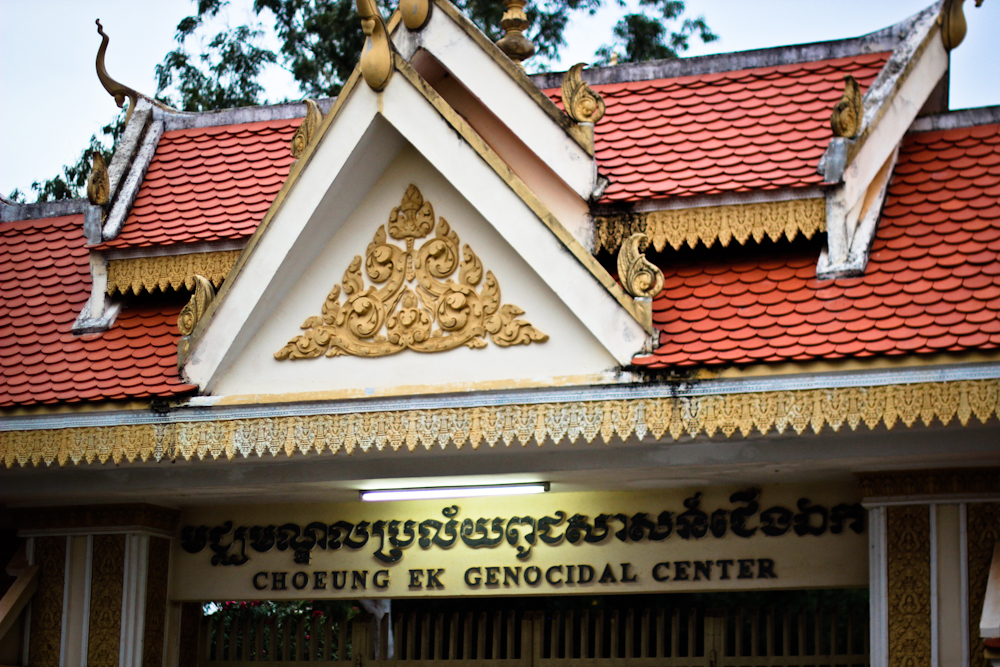
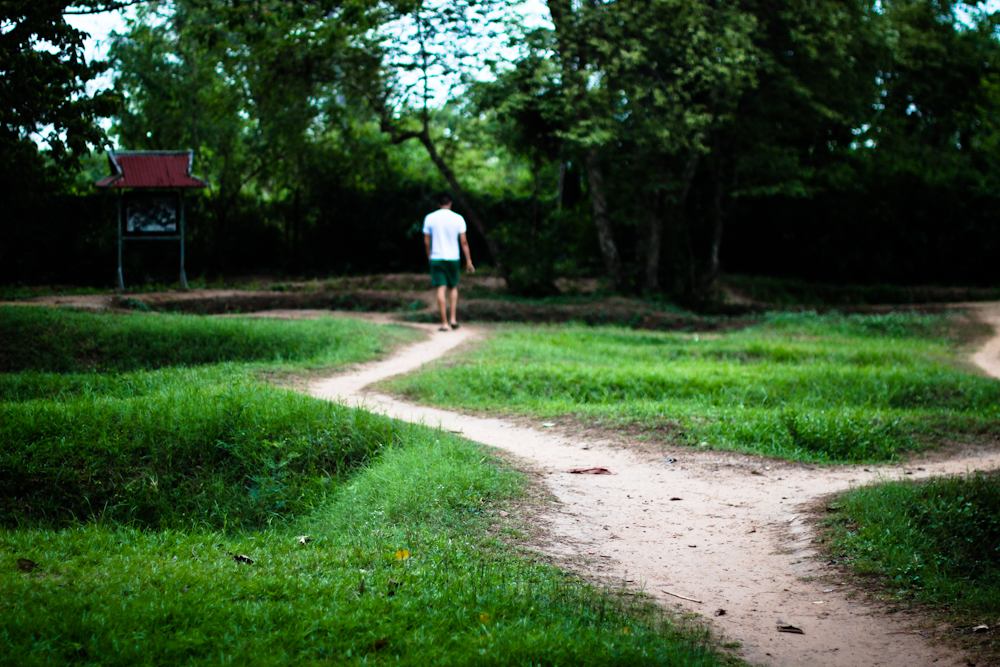
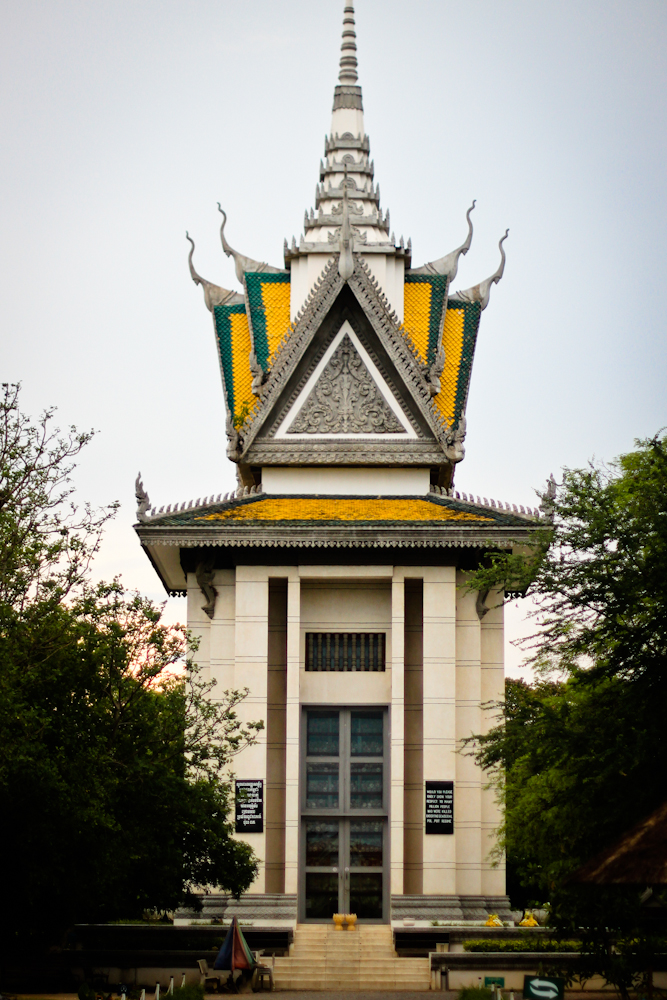
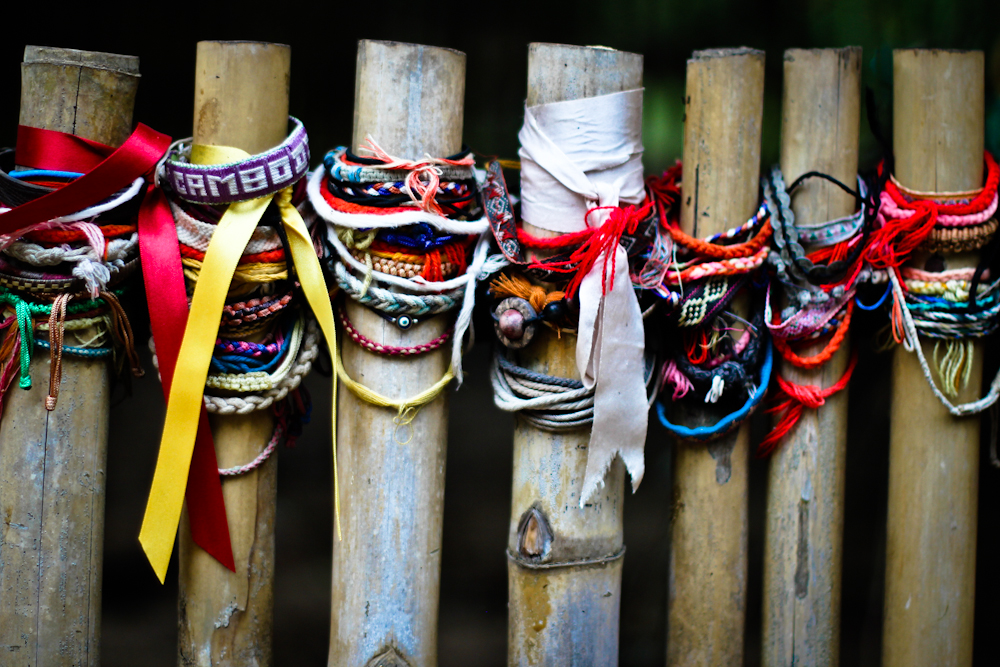


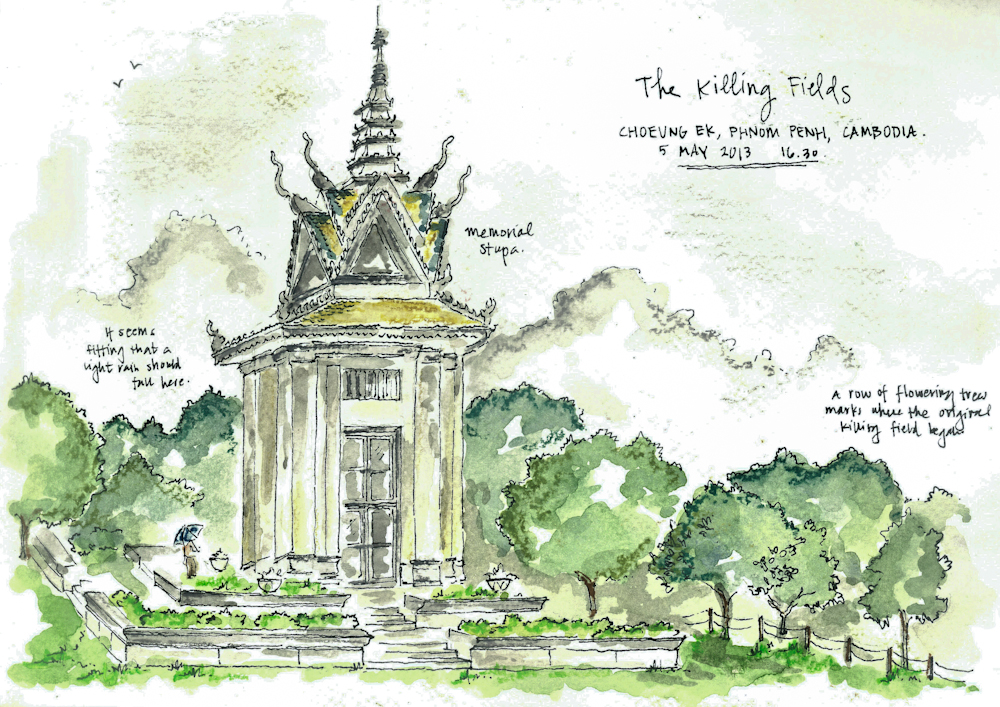
This reminds me of the shoes at Auschwitz. They were there for a different reason of course, since they were the shoes of the victims, removed before the showers. But looking at a massive pile of thousands of shoes, all different shapes and sizes, just made me look at them as very individual. The numbers don’t quite hit home, but somehow looking at the shoes made me think about each and every person those shoes represented. You knew which ones represented kids, which ones were women, and started to put a story together, just by looking at shoes. All those bracelets probably have a story, too.
I can definitely see how the bracelets would remind you of the shoes – and I think when you say, “The numbers don’t quite hit home,” you point out something pretty important…at the end of the day, we don’t personally and emotionally connect with numbers (for instance, listening to all the statistics on my audio guide went straight to my head, not my heart). What we connect with are individuals and their stories…and I think (just as you say) that’s where the shoes and the bracelets come in, reminding us of each specific person affected by these tragedies. Thanks for your comment and your insights!
PS – World War II has always been my favorite period of history to read about, and I would love to visit Auschwitz or another concentration camp one day. I imagine the experience would be pretty similar to visiting the Killing Fields – trying to reconcile what the place is today with the tragedies that took place there in the past.
How interesting…the bracelets weren’t there two years ago when I went, I wonder how it started.
That’s really amazing to hear, Alana. There were so many of them, so I’d love to know how the tradition got started! (I can’t seem to find anything online about it, only photos of the bracelets).
There are indeed few words that would suffice. This is a beautifully written post and I love the idea of these bracelets, appearing like forlorn love locks.
Mandy, the love locks are a perfect comparison to draw between the bracelets – thank you for that! There’s just something about leaving a little piece of us behind, isn’t there? Thanks for reading, and I really appreciate your comment.
Just as you didn’t know how to put your introduction into words, I’m struggling to know how to comment, except to say – well done. This was a beautiful and poignant reminder of the fallen. May they never be forgotten.
Thanks so much for this, my friend…funnily enough, I clicked publish on this last night and then headed over to your blog, only to see that you yourself had just posted about healing in Cambodia (but I then fell asleep before commenting!). I love that that was/is such a theme for both of us there – and I pray that the country continues to heal even more. Miss you!
Haha! Hope I didn’t bore you to sleep 😉 Miss you too my dear!
As *soon* as I pressed ‘reply’ on that comment, I thought – omg! She’s going to read that the wrong way 😉 Not at all, my friend – quite the opposite! Eagerly awaiting your next post.
Such a beautiful recap of what must have been a very emotional visit. I love it for its simplicity, allowing the photos, your sketch and your few words really speak volumes.
Thanks so much, Carmel – we finally got there in the end 🙂 Sometimes I get so caught up in the telling, I have to remember to pull back and just say it how it is. Really glad you enjoyed this one, though, and I hope you’re able to swing through Cambodia once your adventure gets started!
That is so interesting because the bracelets weren’t there when we visited this spot in 2007. I was so incredibly moved by all of our time in Cambodia, horrified by what had happened while the world stood by and watched, saddened by all those left orphaned or damaged by it, and encouraged by the strength of the human spirit and generosity of all we met there. I’m glad it touched you as well.
That’s really fascinating to hear, Rhonda – I wonder who started the tradition and when! And I really appreciate what you shared about your own time in Cambodia – it’s certainly not an easy place to visit, is it? Because the genocide happened in such recent history, I kept wondering how the people I met had been personally affected – but it was such a testament to their spirit that they were still so kind and open to everyone visiting. Thank you for your thoughts!
Your post gave me the chills as I was reading it. Beautifully written!
Thanks so much, Pauline – it was definitely a moving place, just the kind that was hard to find words for initially!
No one had begun leaving bracelets when I visited three years ago… Even just looking at these pictures, not actually being there, I am moved by the display of acknowledgement the bracelets seem to hold… The photos are very powerful.
Jade, it’s so interesting to hear from you and others that these bracelets are apparently quite a new tradition at the Killing Fields – I love what you said about them being a display of acknowledgement, that’s a really beautiful way of putting it. Thanks so much for your comment!
Very beautiful story Candace. It bought tears to my eyes.
Thank you, Jeremy – that means a lot.
What a beautiful, evocative post this was, Candace. We’re in Cambodia now and planning to head back to Phnom Penh tomorrow and the one thing we know we have to do on this visit is delve into this painful part of Cambodia’s past. It’s not something I relish doing, but I know it’s important. As we’ve traveled through the country these past 10 days, we’ve encountered such kindness, such warmth, it’s hard to understand or believe that such atrocities happened here. Yet every person we talk to mentions the Khmer Rouge and the horrors they wrought, and while we can never fully appreciate what that must have been to live through, I think by visiting places like this, we can at least experience the echoes of it.
I’m reminded of our visit to Hiroshima in Japan, a place also remembered in the history books for tragedy. The museum there was very moving and upsetting, but the thing I remember most about the war-related things we saw there are the tributes out in the park made up of thousands of hand-formed paper cranes that come from children all over the world. There’s a story behind those cranes, but just seeing them, in all their multitude of colors and some from so far away, was really touching.
Steph, I can’t thank you enough for taking the time to share your thoughts and insights about Cambodia – it’s been really encouraging to hear from people like you and my friend Hannah of Further Bound, who are also trying to reconcile the kindness you’re encountering there today with the country’s devastating, difficult past. I also loved hearing about those cranes in Hiroshima – how beautiful! – and bet they must have had the same impact on you as the bracelets had on me. I hope the rest of your time in Cambodia goes well, and I especially look forward to hearing about your visit to Phnom Penh.
I visited Choeung Ek little over a year ago, and no such colorful, thoughtful tribute to its victims yet existed. I’m not sure when the bracelets started appearing, but wish I could have seen them – proof of our connection to history – myself. Thanks for the story.
Thanks for saying hello, Kelli! It’s amazing to hear the bracelets weren’t there even just a year ago – there are so many now, they really must have accumulated so quickly. I love what you said about them being a way to connect with history – that’s a beautiful way of putting it.
Sobering.
Thanks for reading this, Karen – it was indeed a sobering place to visit and had me thinking long after I left.